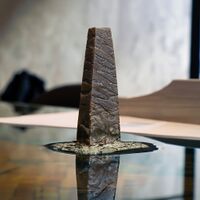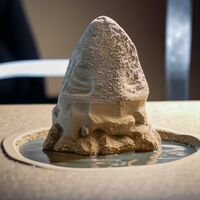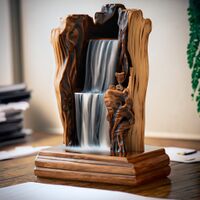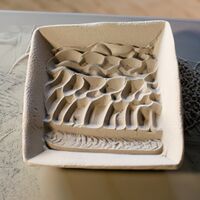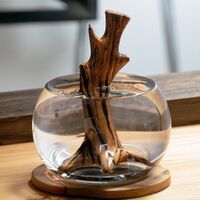Bolian Water Sculpture: Difference between revisions
(Added info on apprentice water sculptors) |
(Categorizing) |
||
| Line 110: | Line 110: | ||
[[Category:Bolian]] | [[Category:Bolian]] | ||
[[Category:Society_and_culture]] | [[Category:Society_and_culture]] | ||
[[Category:Sculptures]] | |||
Latest revision as of 23:58, 26 March 2024
Bolian Water Sculptures are a cultural item found in every strata of their society. They tend to be small in size and incorporate mostly natural elements such as sand, rock, wood, seaweed, and especially water. Specialized Bolian artisans manufacture them to order. Any given Bolian may have one or more of these.
Origin
While the original evolution of Water Sculptures undoubtedly came from early superstitions, the practice of collecting and displaying Water Sculptures remains. The earliest writings indicate that it was considered unlucky to leave the waters of one's birthplace, hence the concept of bringing some of that water along on travels. Given the cultural importance of home and the significance of the nearby waters, the early carrying cases were ornately designed, given the artistic and crafting capabilities of the time.
As societies developed and modernity imposed its ways on Bolian culture, the idea of a "carrying" the waters anywhere was less and less practical. Accordingly, the concept of having home water at one's abode is the modern interpretation of the practice. In antiquity, any water on the sculpture would be easily replenished as they were never far from the shore. As Bolians began migrations on their own world and went into space Water Sculptures tended to be even smaller in size and the designs changed to usually incorporate the waters into the construction so that evaporation would not be a concern. While some designs might even have small waterfalls or pools, those water elements were decorative and are likely not the foundational water to the piece.
Value
They are not replicated, they are hand-made although they need not be made of anything rare or valuable. The value of these items is in the making and the sentimental value given by the owner. Owning a piece by a famed artisan may bring some value to the piece as well. But they are not usually bought or sold by Bolians. However, some have been found for sale on secondary markets off-world. Even then, it is the rarity of the sculpture itself that may give it any value. Many Bolians would consider it vulgar or ostentatious to commission a piece with many precious metals or rare gems and the like. It would be considered to detract from the intrinsic value of the meaning of the water itself, which is supposed to be at the center of the artist's vision for the piece.
Construction
The construction is usually of naturally occurring items such as stones, wood, kelp, beach sand, and the like. Metals and similar are used as binders or for support but are not normally at the center of the design. Most Bolian artisans use whatever is plentiful near their place of crafting. Accordingly, if a given Bolian desired a sculpture that inspired thoughts of a stream through a forest, she might look for an artisan that specialized in wood sculptures and he or she would undoubtedly live near a forest of some kind.
It's not important that the construction elements come from the home world or from any particular place. If there is a Bolian colony on some far away world, all the Bolians there would be perfectly happy with the local raw materials in the designs. The only exception is the primary component: the water.
The sculptures are not powered and do not have any modern technology in the final product. However some artisans may use very modern tools in the workshop to assist in manufacturing them. Once in their eventual home, they may be displayed with lighting or kept in forcefields to prevent evaporation if the primary water is exposed.
Primary Water
Every Water Sculpture must contain water provided by the one who commissions the art. No Bolian artisan would substitute any other water or use his or her own in the construction. The selection and delivery of the primary water is entirely within the purview of the eventual owner. How the primary water is incorporated into the sculpture is entirely at the discretion of the artisan. It may be put into a completely sealed glass tube. Or mixed with sand and then formed into a shape that is fire-fused into place. There are many options.[1]
Style
There is a huge variation in appearance and style. They range from the concrete to the abstract. Each one is custom made to suit the preferences of the customer.
Each sculptor may specialize in certain styles or motifs as well. Generally the most popular styles evoke the ocean, the beach, sea waves, or forests. But there are no real rules, except that the primary construction elements are usually naturally occurring items such as rock, sand, wood, and the like. Metals and more modern elements can use used as fasteners, pedestals, and the like but they would not be considered primary elements in the final product.
Life forms, sentient or otherwise, are not considered appropriate content for inclusion in a Water Sculpture design.
Size
Most Water Sculptures range from 5 to 20 cm tall and vary from 5-10 cm per side. The origin of these items was to keep some of the waters from home nearby while traveling, so large sculptures are not appropriate.
Acquisition
Water Sculpting tends to be a niche and highly specialized calling for some Bolian artists. It would be rare to find one who does water sculpting in addition to painting for example, at least as an alternate artistic endeavor. Certainly as a private pursuit, sculptors can engage in whatever art they find pleasing. But their public works would be almost exclusively Water Sculptures. An artist who dabbles in water sculpting would be considered a dilettante and would tend not to get many commissions.
The list of sculptors is well-known and publicized. Each entry would list their interests in which kinds of commissions they might take, their preferred styles, samples of previous works, and their current wait list time. No sculptor makes these to stock or for general sale. Such a thing is not possible since there is no primary water. Each one is always and everywhere made to order.
Some craftspeople follow a first-come first served order. Some will require a statement on why their work is sought after. Some may require to hear the story of the primary water. Any sculptor can accept or decline a commission at their own whim.[2]
Once a commission is accepted, the customer has to deliver the primary water to the artist before work can begin.
Each artist works in their own way. Some may involve the client in the design, showing sketches and such through the project. Others may not. Each artist's tendencies are usually known in advance and are mutually agreed upon.
Construction time and delivery can be whatever is negotiated. This is considered quite transactional.
Sculptures can also be inherited and/or passed off between close friends, family, and romantic interests.
Occasions
Bolians may commission a sculpture for any personal reason or purpose. They may order one for themselves or as a gift. Gifting a sculpture is something that close friends, family, romantic interests, or others involved in each other's lives do. These are never given casually.
Some examples may include:
| Occasion | Client | Primary Water |
|---|---|---|
| Youth moving out of the childhood home | Parent | From the lake next to the childhood home[3] |
| Starting a new career | Self | Water from near the new job location |
| New romance | Romantic partner | Collected rain water from near the place they originally met |
| Death | Surviving partner | Water from the ocean near where the decedent passed |
| Personal achievement
(Promotion, athletic goal, etc..) |
Self | Nearby lake water from the place the event occured |
Social Practices
Bolians may have one, a few, or many sculptures. They are displayed with pride in the home and have a place of prominence. A visitor will always be shown the sculptures upon a first visit. Comments about their artistic merit and beauty are welcome and appreciated. Inquiring as to the artisan who made any given one are acceptable.
However it is considered extremely rude to ask about the Primary Water, where it came from and the occasion that led to its commission. These may be deeply private and may not be something shared with casual company. The full history of each one is something that is reserved for the closest of friends, family, and romantic interests. The artisan who made it may also be informed as to the history, if they make it a term of the commission.
The only real exception is if a given visitor had a part to play in the reason for the sculpture's creation. Anyone, even a casual acquaintance who was present at the event that spurred the Bolian to commission a sculpture, can be told all about it. As an example, a Bolian Starfleet Officer might get assigned to an Away Team with a brand-new officer she had never met. Something happens on the Away Team that makes our Bolian Officer commission a Water Sculpture. The other officer would be invited to see the sculpture and told of its significance since they were a part of the story of its inception. But no other Officers at the command would be told, unless they were close personal friends or romantically involved with the Bolian.
Language
In the Bolian language these are called Ajah Mai, best translated as "Sea Souls". Water Sculptors are called Ajahi Mailos, or "Sea Soul Talkers".[4] [5] An apprentice Water Sculptor is called an Ajahi Mailosin. [6]
Sample Water Sculptures
References
- ↑ "Breakfast of Champions", Ensign Zenno, USS Arrow
- ↑ "Supplication Snafu", LT (jg) Zenno, USS Arrow
- ↑ "An Unexpected First Contact", Ensign Zenno, USS Arrow
- ↑ "Thinking of the Sea", Ensign Zenno, USS Arrow
- ↑ "Don't You (Forget About Me) (Part 3A)", LT (jg) Zenno, USS Arrow
- ↑ "Unexpected Mail Call", Lt Zenno, USS Arrow
